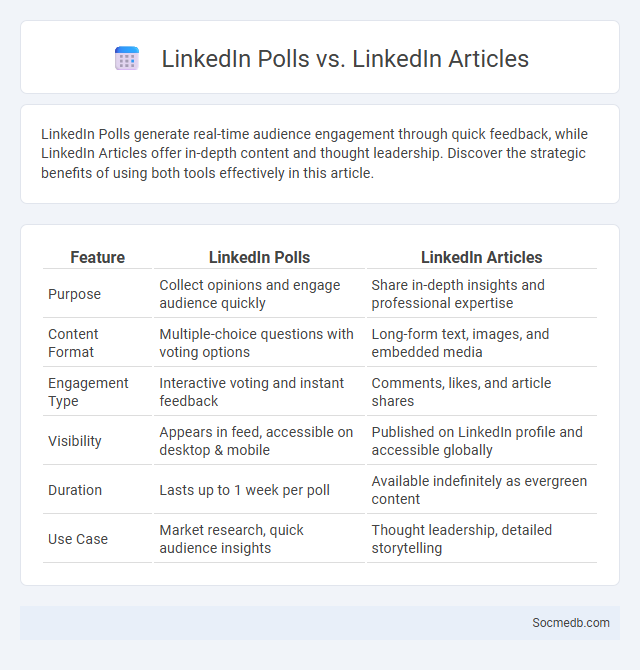
Photo illustration: LinkedIn Polls vs LinkedIn Articles
LinkedIn Polls generate real-time audience engagement through quick feedback, while LinkedIn Articles offer in-depth content and thought leadership. Discover the strategic benefits of using both tools effectively in this article.
Table of Comparison
| Feature | LinkedIn Polls | LinkedIn Articles |
|---|---|---|
| Purpose | Collect opinions and engage audience quickly | Share in-depth insights and professional expertise |
| Content Format | Multiple-choice questions with voting options | Long-form text, images, and embedded media |
| Engagement Type | Interactive voting and instant feedback | Comments, likes, and article shares |
| Visibility | Appears in feed, accessible on desktop & mobile | Published on LinkedIn profile and accessible globally |
| Duration | Lasts up to 1 week per poll | Available indefinitely as evergreen content |
| Use Case | Market research, quick audience insights | Thought leadership, detailed storytelling |
Understanding LinkedIn Polls: Quick Engagement Tool
LinkedIn Polls offer your network a quick and interactive way to share opinions and gather valuable insights in real-time, enhancing audience engagement effectively. These polls boost visibility by encouraging meaningful participation through targeted questions relevant to your industry or professional interests. Utilizing LinkedIn Polls strategically can increase your content reach and foster stronger connections within your professional community.
The Power of LinkedIn Articles for Thought Leadership
LinkedIn Articles offer a powerful platform for establishing your thought leadership by showcasing in-depth expertise and industry insights. Publishing regular, well-researched content boosts your professional credibility and expands your network among key decision-makers. Leveraging LinkedIn's targeted algorithms ensures your articles reach the right audience, maximizing engagement and influence.
How LinkedIn Feed Ranking Works
LinkedIn Feed Ranking uses machine learning algorithms to personalize content based on user interactions, such as likes, comments, and shares, ensuring the most relevant posts appear first. The system evaluates factors like user affinity, content popularity, and recency to optimize engagement and keep the feed dynamic. By prioritizing professional interests and network connections, LinkedIn enhances user experience and fosters meaningful interactions within its platform.
Audience Reach: Polls vs Articles vs Feed
Polls on social media generate high engagement by encouraging direct interaction, boosting audience reach through shares and comments. Articles provide in-depth content that attracts users seeking detailed information, extending reach through saves and link shares. Feed posts, combining multimedia elements like images and videos, achieve broad visibility by appealing to diverse audience preferences and maximizing algorithmic exposure.
Content Visibility: Maximizing Your Impact
Maximizing your content visibility on social media requires strategic use of hashtags, engaging captions, and optimal posting times aligned with your target audience's online activity. Leveraging platform-specific algorithms by encouraging interactions such as likes, shares, and comments boosts the reach of your posts organically. You can also enhance impact through consistent branding and incorporating multimedia elements like images and videos to capture attention and increase engagement rates.
Engagement Metrics: What Performs Best?
Engagement metrics such as likes, comments, shares, and click-through rates are key indicators of social media success, with video content consistently outperforming static images and text posts in driving user interaction. Platforms like Instagram and TikTok show higher engagement rates for short-form video content optimized for mobile viewing and algorithmic promotion. User-generated content and interactive features like polls and stories also significantly boost engagement by fostering community participation and authentic connections.
Algorithm Insights: What Influences the Feed?
Social media algorithms prioritize content based on factors like user engagement, relevance, and recency to personalize your feed effectively. Machine learning models analyze your interactions, such as likes, shares, and comments, to predict content that aligns with your interests. Understanding these algorithm insights helps optimize your content strategy for maximum visibility and engagement.
Use Cases: When to Choose Polls, Articles, or Posts
Polls are ideal for engaging audiences through interactive feedback on preferences or opinions, boosting real-time participation metrics. Articles serve as comprehensive content pieces for in-depth information sharing, suitable for thought leadership and detailed storytelling to enhance brand authority. Posts deliver quick updates, announcements, or promotional messages that maximize visibility and immediate audience reach across social media platforms.
Tips to Optimize Content for LinkedIn Feed Ranking
Optimize LinkedIn content by using relevant keywords and industry-specific hashtags to enhance visibility in feed rankings. Incorporate engaging media such as high-quality images or videos, which significantly boost user interaction and dwell time. Craft concise, value-driven posts that encourage comments and shares, as LinkedIn's algorithm favors engagement signals to prioritize content distribution.
Strategic Recommendations for LinkedIn Content Creators
LinkedIn content creators should prioritize publishing industry-specific insights and thought leadership posts to engage a professional audience. Utilizing native video and carousel posts increases visibility and encourages higher interaction rates, while consistent posting schedules strengthen brand awareness. Leveraging LinkedIn Analytics helps refine content strategy by identifying top-performing topics and optimal posting times, maximizing reach and follower growth.
 socmedb.com
socmedb.com